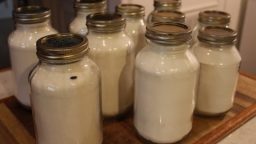Did you know there’s such a thing as canning flour? Neither did I, but I recently came across a video with instructions on how to do it. I’ve dealt with both weevils and pantry moths in the past, so I was pretty intrigued by this method, and it definitely seems like a surefire way to store flour for a long time.
It’s not really as complicated as canning other types of food, but it follows the same principles. Here is what you need:
Supplies:
Flour that you want to preserve
Half-gallon canning jars and lids
Canning funnel (very useful, but optional)
Paper towels and dish towels
Labels or marker
Instructions:
- Before you begin, start with properly sanitized jars. You can do this by washing, drying, and baking in the oven for about 20 minutes.
- When you’re ready to can your flour, preheat your oven to 215 degrees
- Using the canning funnel (if you’ve got one), fill your jars with flour. Make sure they’re packed in well, you can gently tap the car on the counter to let the flour settle in the jars.
- When your oven is preheated, move your oven racks so you will be able to fit the jars, and place them on a sheet in the oven, without the lids.
- Leave in the oven for 1-2 hours. This will dry out the flour and prepare the jars for the “canning” effect.
- After 1-2 hours has passed, take the jars out (carefully!) and place on a dish towel on your counter
- Wipe down the rims of the jars with a damp paper towel, then attach the lids as tightly as you can
- Leave the jars out overnight on the counter. In this time, they will cool and pop the lids out, completing the canning process.
- In the morning, label the jars with the date you canned them.
- Store in a cool, dark places, for up to five years.
That’s it! Pretty cool huh? Check out the video if you’d like to see more:
If you enjoyed this, you might also like….


